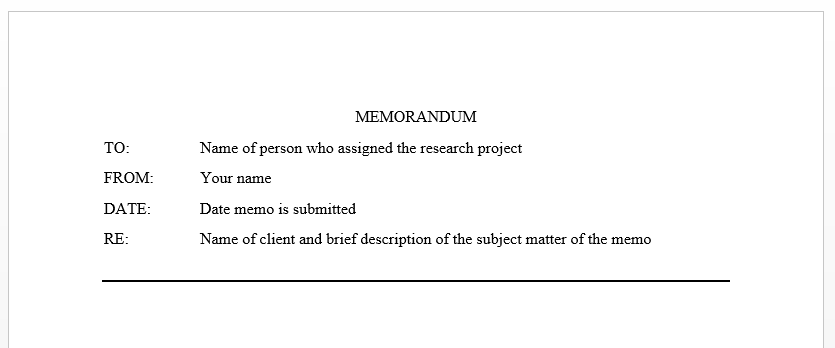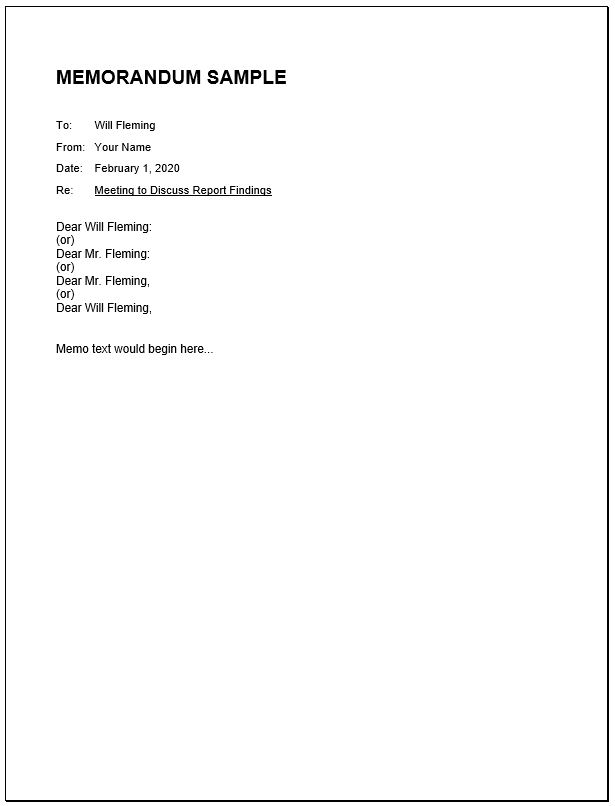A memo (short for memorandum) is a type of document typically used to communicate with others in the same organization. Memos (or memoranda) are generally used for fairly short messages of a page or less, but informal reports of several pages may also employ the memo format. While many workplaces use email (whose format originates in the memorandum—see Figures 4.2.1 and 4.2.2 below) for communication, it is still important for technical writers to know how to properly format and use printed memos.
Memo Heading
Memos, like emails, begin with a header block that includes the following:
-
-
- HEADING: Capitalize and make bold the heading—MEMO or MEMORANDUM is sufficient.
- TO: List the names of the recipients of the memo. If there are several recipients, it’s acceptable to use a group name, such as “All Faculty” or “Hiring Committee Members.”
- FROM: List the writer’s name(s) (sometimes the job title is also included).
- DATE: List the date on which the memo is distributed.
- SUBJECT (RE): Include a subject that functions like a title (specificity is helpful here so that readers can immediately identify the memo’s topic).
-
*Other lines, such as CC (carbon copy) or BCC (blind carbon copy), may be added as needed.
Figure 4.2.1 shows a typical header block for an email, while Figure 4.2.2 shows a typical header for a memo; note the similarities between the two:


The order listed above is the most common memo structure, but the order of items can vary, especially when organizations have their own style preferences for letters and memos. Figure 4.2.3 shows a standard memo layout:

Memo Content
Memo text uses block letter format, with single-spaced lines, an extra space between paragraphs, and no indentations for new paragraphs. However, if a report using a memo format stretches to a few pages in length, double spacing may be used to improve its readability.
Organize the content of your memo so that it answers the following questions for the reader:
-
-
- Opening: Do I have to read this? Why do I have to read this?
- Details: What do I need to know?
- Closing: What am I expected to do now?
-
Memos are generally direct and concise. There is no need to start with general introductions before getting to your point. Your readers are usually colleagues within the same organization, and are likely familiar with the context in which you are writing. The subject line and opening sentences of the memo’s message should make it clear to the reader whether they have to read the entire memo and why (if, for example, the memo is informing readers about a parking lot that’s closed on campus that I never use, then I don’t really have to read any further).
The middle section of the message should give all of the information and details needed to adequately inform the readers and fulfill the purpose of the memo. Start with the most general information, and then add the more specific facts and details. Make sure there is enough detail to support your purpose, but don’t overwhelm your readers with unnecessary details or information that is already well known to them.
The final part of the message is the action, indicating what, if any, action is required or requested of your readers. If you are asking your readers to do something, be as courteous as possible, and try to indicate how this action will also benefit them.
For more information, watch the following video, “Writing the Basic Memo,” from Upwrite Press:
*Click here for a sample of a student’s memorandum for a technical report—pay special attention to its layout and how the writer uses helpful subheadings to assist the reader in navigating the document and its information.
Additional Resources
- “Memos” from the Purdue OWL
- “Memorandums and Letters” from Business Communication for Success
CHAPTER ATTRIBUTION INFORMATION"7.1 Correspondence." Technical Writing Essentials. [License: CC BY-SA 4.0] "Memos and Emails." Open Technical Writing. [License: CC BY 4.0] "The Key Forms of Business Writing." Uploaded by UpWritePress, 2 Sept. 2009, Youtube.com. |

